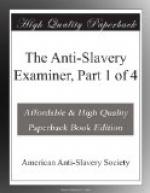In conclusion, I argue the power of Congress to abolish slavery in the District, froth Art. 1, sec. 8, clause 1, of the constitution: “Congress shall have power to provide for the common defence and the general welfare of the United States.” Has the government of the United States no power under this grant, to legislate within its own exclusive jurisdiction on subjects that vitally affect its interests? Suppose the slaves in the District should rise upon their masters, and the United States’ government, in quelling the insurrection, should kill any number of them. Could their masters claim compensation of the government? Manifestly not; even though no proof existed that the particular slaves killed were insurgents. This was precisely the point at issue between those masters, whose slaves were killed by the State troops at the time of the Southampton insurrection, and the Virginia Legislature; no evidence was brought to show that the slaves killed by the troops were insurgents; yet the Virginia Legislature decided that their masters were not entitled to compensation. They proceeded on the sound principle, that a government may in self protection destroy the claim of its subjects even to that which has been recognised as property by its own acts. If in providing for the common defence the United States government, in the case supposed, would have power to destroy slaves both as property and persons, it surely might stop half-way, destroy them as property while it legalized their existence as persons, and thus provided for the common defence by giving them a personal and powerful interest in the government, and securing their strength for its defence.
Like other Legislatures, Congress has power to abate nuisances—to remove or tear down unsafe buildings—to destroy infected cargoes—to lay injunctions upon manufactories injurious to the public health—and thus to “provide for the common defence and general welfare” by destroying individual property, when it puts in jeopardy the public weal.
Granting, for argument’s sake, that slaves are “property” in the District of Columbia—if Congress has a right to annihilate property in the District when the public safety requires it, it may surely annihilate its existence as property when public safety requires it, especially if it transform into a protection and defence that which as property periled the public interests. In the District of Columbia there are, besides the United States’ Capitol, the President’s house, the national offices, &c. of the Departments of State, Treasury, War, and Navy, the General Post-office, and Patent Office. It is also the residence of the President, all the highest officers of the government, both houses of Congress, and all the foreign ambassadors. In this same District there are also seven thousand slaves. Jefferson, in his Notes on Va. p. 241, says of slavery, that “the State permitting




